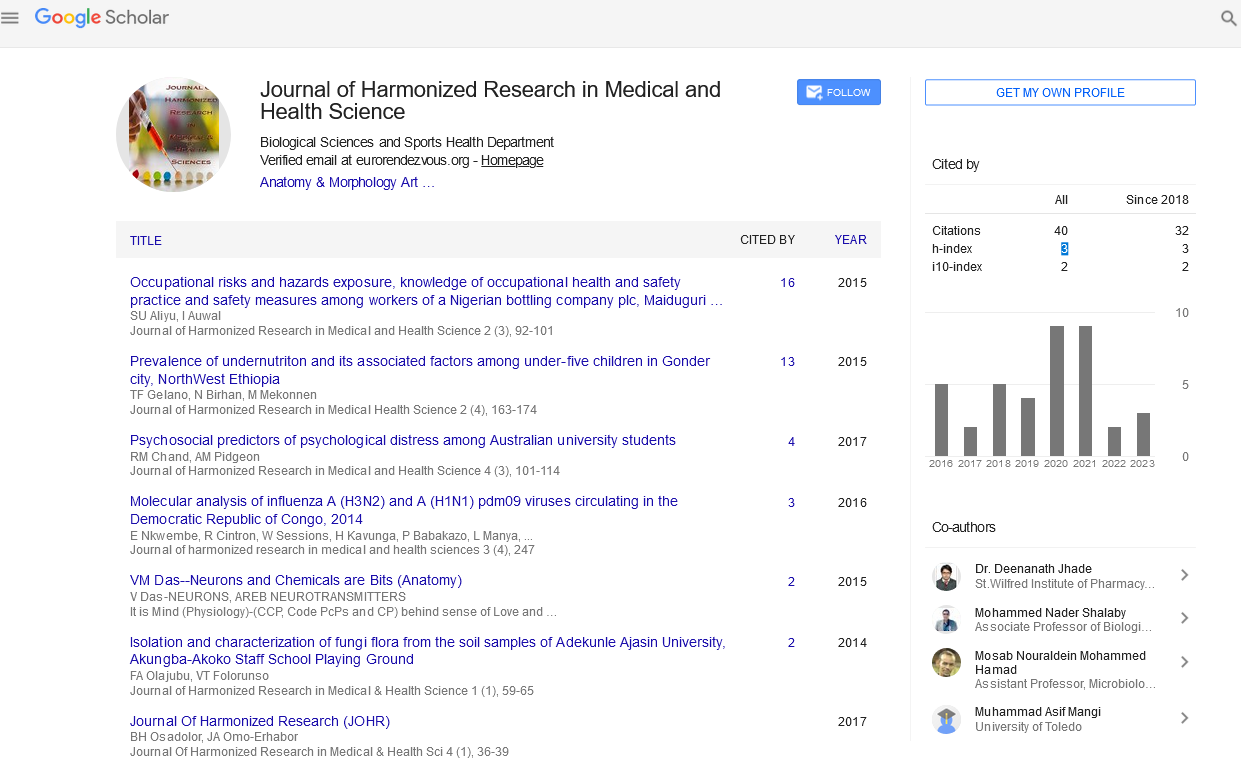Short Commentary - (2022) Volume 9, Issue 2
DISCUSSION OF CELL BIOLOGY PRINCIPLES AND CONCEPT
Anita Arora*Received: May 27, 2022, Manuscript No. JHRMHS-22-69943; Editor assigned: May 30, 2022, Pre QC No. JHRMHS-22-69943(PQ); Reviewed: Jun 13, 2022, QC No. JHRMHS-22-69943; Revised: Jun 20, 2022, Manuscript No. JHRMHS-22-69943(R); Published: Jun 30, 2022, DOI: 10.30876/2395-6046.22.9.128
Abstract
Description
The field of biology known as “cell biology” focuses on understanding the composition, operation, and behaviour of cells. Cells comprise all living things. A cell is the fundamental building block of life [1]. A cell is what keeps organisms alive and keeps them operating properly. The study of the structural and operational components of cells is called cell biology. Prokaryotic and eukaryotic cells are included in the study of cell biology, which also includes several subtopics such as the study of cell metabolism, cell communication, cell cycle, biochemistry, and cell composition [2]. Cell culture, cell fractionation, and other microscopy techniques are used in the study of cells. These have made it possible and are still being used to make discoveries and conduct studies into how cells work, ultimately revealing new information about larger species. Understanding the parts of cells and how they function is crucial to all biological sciences and is also required for biomedical research in areas like cancer and other disorders[3]. Research in various domains such as genetics, molecular genetics, molecular biology, medical microbiology, immunology, and cytochemistry is tied to those in cell biology. Prokaryotic and eukaryotic are the two main divisions of cells. Because prokaryotic cells lack a cell nucleus or another membrane-bound organelle, they can be separated from eukaryotic cells. Prokaryotic cells are the tiniest forms of life since they are significantly smaller than eukaryotic cells. Bacteria and Achaea are examples of prokaryotic cells, which are devoid of an enclosed cell nucleus. Animals, fungus, plants, and weeds all have eukaryotic cells. Their DNA is housed in a membrane-bound nucleus, and their diameter ranges from 10 m to 100 m. Organisms with eukaryotic cells are known as eukaryotes. Animally, Plantae, Fungi, and Protista are the four kingdoms of eukaryotes [4].Both of them use binary fission to reproduce. Although most bacteria are spherical or rod-shaped, the most common type of bacteria can take on a variety of shapes. Depending on the makeup of the cell wall, bacteria can be classified as either gram-positive or gramnegative. The peptidoglycan layer of gram-positive bacteria is thicker than that of gram-negative bacteria. A flagellum, which aids in cell movement; ribosomes, which translate RNA into protein; and a nucleoid, which houses the entire genome in a circular structure, are all examples of structural elements found in bacteria. Prokaryotic cells can survive thanks to a variety of events that take place within them [5]. In prokaryotes, the DNA template’s promoter sequence, which consists of two consensus sequences that attract RNA polymerase, is where mRNA synthesis begins? A four-protein core enzyme and a protein that solely aids in initiation make up the bacterial polymerase. For instance, during a process known as conjugation, the fertility factor enables the bacteria to have a piling that enables it to transmit DNA to other bacteria that do not have the F factor, allowing the transmission of resistance and enabling it to thrive in specific settings.
Conclusion
Numerous pathways make up cell metabolism, which is essential for the cell to produce the energy it needs to survive. Once glucose is available for cellular respiration, glycolysis takes place in the cell’s cytosol to create pyruvate. Utilizing a multi-enzyme complex, pyruvate is decarboxylated to create acetyl coA, which is easily used in the TCA cycle to make NADH and FADH2. These goods are a part of the electron transport chain, which eventually results in the formation of a proton gradient across the inner mitochondrial membrane. The generation of ATP and H2O during oxidative phosphorylation can then be driven by this gradient. Photosynthesis, which is just the opposite of respiration in that it ultimately results in the production of glucose molecules, is a component of metabolism in plant cells.
References
- Siekevitz P, Palade GE. A Cytochemical Study on the Pancreas of the Guinea Pig: V. In vivo Incorporation of Leucine-1-C14 into the Chymotrypsinogen of Various Cell Fractions. The Journal of Cell Biology. 1960:7(4):619-630.
[Crossref] [Pubmed] [Google Scholar]
- Jameison JD, Palade G. Intracellular transport of secretory proteins in the pancreatic exocrine cell. I. Role of the peripheral elements of the Golgi apparatus. J Cell Biol. 1967:34:577-98.
[Crossref] [Pubmed] [Google schlor]
- Rossner M. Figure manipulation: assessing what is acceptable. The Journal of Cell Biology. 2002: 158(7):1151-1153.
- Jamieson JD, Palade GE. Intracellular transport of secretory proteins in the pancreatic exocrine cell: IV. Metabolic requirements. J Cell Biol. 1968:39(3):589-603.
[Crossref] [Pubmed][Google Scholar]
- Rossner M. The JCB 2003: progress, policies, and procedures. The Journal of Cell Biology. 2003:161(5):837.










